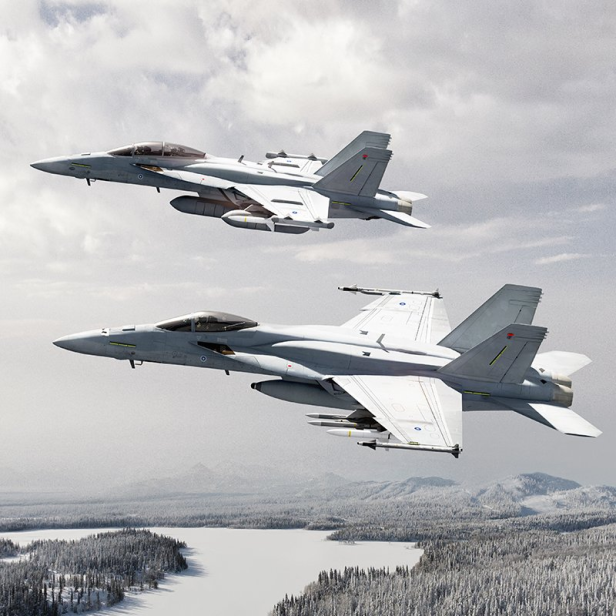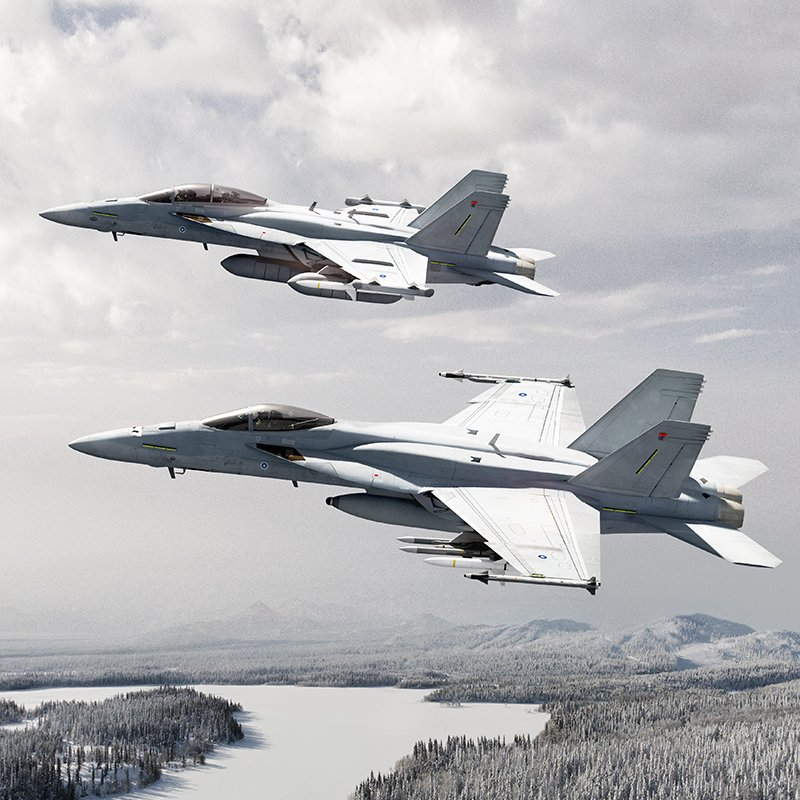News recently broke from Denmark that the cost of the new light hangars and other infrastructure being added to Skrydstrup Air Force Base in anticipation of the arrival of the first F-35s has almost doubled from 650 million DKK (87 MEUR) to 1.1 billion DKK (150 MEUR). The news itself isn’t quite as dramatic as it looks, part of the changes stems from a change in the decision of where on the base the buildings will be placed, and it actually matches the savings of 443 million DKK (58 MEUR) that the cost of the aircraft themselves have experienced since the acquisition approval in 2016 (part of which is the drop in price of the F-35A, part of which is a more favorable exchange rate), leaving the 20 billion DKK (2.7 billion EUR) total budget largely unaffected. However, it does highlight an often overlooked issue with fighter programs, namely that a new fighter is seldom just able to drop into the slot left by an outgoing aircraft. No two transitions are exactly alike, but it does offer an interesting perspective that in the case of Denmark, infrastructure representing 5% of the value of the fighter package will have to be built, and it is something to keep in mind in February when two different Boeing-built fighters will touch down at Tampere-Pirkkala to take their turn in HX Challenge.

The Boeing F/A-18E/F Super Hornet and EA-18G Growler namely are more or less plug and play when it comes to using the existing Finnish Air Force infrastructure. Granted there are likely some obsolescence issues, general need for modernization, and the simulators will have to be replaced/seriously updated, but in general the Super Hornet can jump right in where the Hornet is currently. Exactly how much that benefit is worth compared to the competitors is unclear, but with all manufacturers having problem squeezing 64 fighters into the 10 Bn Euro budget, that also include these kinds of infrastructure changes, Boeing will have a measurable advantage.
But it doesn’t stop there, as the Super Hornet fleet would be able to utilise many of the weapons currently found in the arsenals of the Finnish Air Force. These include not only the ubiquitous AIM-120C-7 AMRAAM and the somewhat less widely certified AIM-9X, but also the JDAM and JSOW, which aren’t in use by the eurocanards. While the timeline until the retirement of the Hornet is long enough to allow for a bit of planning in arms acquisitions, the savings in weaponry can quickly start adding up, and also ensures that there isn’t a gap in missiles orders but a rolling transition which makes stepped buys of HX-weaponry easier on the budget post-2030. An interesting weapon is the silver bullet AGM-158 JASSM, which reportedly has a shelf-life roughly stretching to the end of the Finnish Hornet-era. As it is safe to assume that any Finnish Super Hornet-fleet would use the JASSM as their long-range strike weapon, this would open up the possibility of a JASSM-overhaul (possibly including some features of the current AGM-158B JASSM-ER model) that likely would be cheaper than acquiring new-built Storm Shadows.
Renders are always an interesting subject, as they provide an indication of what the manufacturer sees as the aircraft’s strong cards. In the render above Boeing has not only included the mid- and low-band NGJ pods (Next-generation jammers) currently undergoing testing and an AGM-88E AARGM anti-radiation missile on the Growler, but the single-seat F/A-18E Super Hornet feature the AARGM as well, in addition to a podded IRST-sensor and a respectable air-to-air load of six AIM-120 AMRAAM and two AIM-9 Sidewinder missiles. Considering that the Finnish Air Force places an emphasis on the counter air mission, i.e. the “candidate’s capability to perform in combats both with fighters and ground based air defence”, this is a serious combat load for the mission (it might in fact be overtly ambitious as a general load considering the cost of the weapons involved) as it allows the aircraft to not only target enemy aircraft, but to force enemy ground-based radars to either go dark or risk receiving an AARGM-sized hole in their arrays. While the basic F/A-18E isn’t capable of the kind of widespread jamming as the Growler, it does bring more shooters to the SEAD-battle compared to just having a handful of Growlers. For those interested in the lack of external fuel tanks, it should be noted that the aircraft carry conformal fuel tanks, and that this is Finland and not to the USINDOPACOM, so range requirements are rather modest.
In the meantime the Finnish Air Force is building it’s multirole capabilities, which will carry on to the HX. In the clip above from current high-end exercise KAAKKO 19 soldiers of Kymi Jaeger Battalion provide suppressive fire while a JTAC first directs artillery fire onto target, and then directs a live JDAM drop from a Hornet to finish off. While one can discuss the role of the JDAM in contested airspace, the preferred high and fast drop profile isn’t necessarily a great idea if inside enemy SAM coverage, the modern low-density battlefield does provide settings where it could come in handy.
But the low-density battlefield doesn’t just create opportunities for the Air Force to pound enemy ground forces outside of their integrated air defences, it also places high demands on issues such as situational awareness to avoid own losses, both in the air and for the units being supported on the ground. While not the most talked about features of the Block III compared to earlier versions of the Super Hornet, two items brought in with it gives huge improvements in this field: the Distributed Targeting Processor-Networked (DTP-N) and the Tactical Targeting Network Technology (TTNT) data link. The short version is that the TTNT gives more bandwidth compared to legacy datalinks, allowing more information to be transferred between aircrafts (and other sensors), while the DTP-N gives the computing power to be able to make sense of this increased data flow by fusing not only data from the aircraft’s own sensors, but from the sensors of other aircraft as well. Together they allow for the creation of a Common Tactical Picture (CTP), ensuring that all aircraft knows what any of them sees.
Now, the CTP could potentially provide the answer to one of the headaches Boeing is likely facing, namely the F/A-18E + F/A-18F + EA-18G mix. The basic fighter in the (approximately) 64 aircraft fleet will be a single-seater, in this case the F/A-18E. In addition, a number of twin-seaters will likely be included to allow for training, in this case the F/A-18F. The Finnish legacy-Hornet fleet was made up of 57 single-seaters and seven twin-seaters, with the Finnish Air Force publicly stating that in hindsight they would have preferred a larger amount of twin-seaters (this led to the unfortunate “frankenfighter”, HN-468). E.g. Saab has solved this by offering a 52 + 12 mix of single- and twin-seaters, noting that twin-seaters offer better performance in a number of missions, including SEAD/DEAD, complex ground-attack scenarios, or with the backseater working as a mission commander.

The headache for Boeing is the fact that the EA-18G already takes up precious slots in the fleet. Looking at the typical carrier aircraft wing, it is likely that something along the lines of eight to twelve Growlers are included in the Finnish offer. Twelve standard twin-seaters would leave an Air Force with only 40 single-seaters, and while the twin-seaters are fully combat capable, there are additional costs associated with them (and with training WSOs/mission commanders). The Growlers in particular, while extremely capable and impressive, come with a premium price tag. The question then is whether the number of Fs could be scaled back? Notably the F-35A is offered only as a single-seater, and with modern fighters being easier to fly compared to legacy aircraft has made it possible to shift all or parts of conversion training to simulators and single-seaters. There is also no particular need for SEAD-configured F/A-18Fs, since that is what the EA-18G Growler is all about. The Finnish Air Force also currently flies the majority of the ground-attack missions, including long-range strike missions, with single-seat F/A-18C Hornets. The idea behind a mission commander is interesting on paper, but considering the generally improved situational awareness presented by wide-angled displays and the CTP, it is questionable if it provides enough of an edge to justify a serious buy of F/A-18Fs. Instead, leaving the mission commander role to either ground control or the senior F/A-18E pilot might very well be the desired outcome. The final ratio will likely be decided only once the wargames are over, but don’t be surprised if the number of F/A-18Fs is on the lower end.


Just a minor correction: 20 billion DKK isnt €268M but €2,68 BILLION !……which is still just about a quarter of the Finnish budget for a little less than half the number of planes. Aptly illustrating how ridiculously underfunded the danish fighter acquisition project really is.
More to the point of the article, while there is little doubt that right now the F18 E/F would be the most straightforward choice, giving great VMF and ensuring a cheap and easy transition from your existing F18 Hornet fleet,
But while the Super Hornet Block III/ Growler combo is obviously very capable and surely more than adequate at present, what about in 10 years ?..20?…or 30?………with limited development and growth potential left in the platform, i just cant see the super bug remain relevant into the 2060s .
For all the bad rep stealth has gotten the last few years , having been basically declared obsolete already , i’ll note that pretty much every single new fighter in development or on the drawing board, whether manned or unmanned , is incorporating prominent stealth features ala F-22 and F-35. The same goes for most UAV/UCAV designs.
Features that the F-18 platform lacks and will never have, and as such it WILL be handicapped, not just relative to its friendly competitors, but more importantly against potential adversaries fielding their own stealth fighters.
Whoops! Thanks for catching that decimal error! The big question is obviously how the field will look in thirty years, I’m not jealous of the people that have to rank the growth potential of the aircraft. However, the Super Hornet does have two important factors: power and space, if that’s enough remains to be seen.
And i’m even less jealous of the person who has to fit explanation why choose fighter x on a single A4 sheet, so average politican understands it…
And just to correct my own mistake, VMF should of course have been VFM or Value For Money.